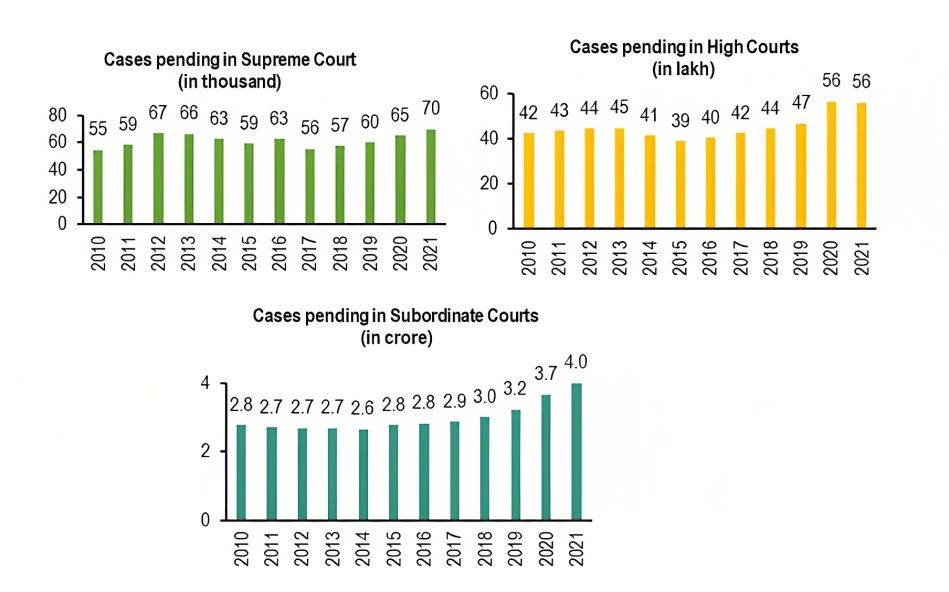Description

Copyright infringement not intended
Context: The collegium of the Supreme Court has recommended that a former district judge be appointed as a judge of the Madhya Pradesh High Court.
Details
- The collegium elaborates on its recommendation of the Judge "On the date of the vacancy against which his name was recommended, he was 58 and thus qualifies with reference to the prescribed age criterion."
- The collegium recommended his appointment as HC judge based on his "legitimate expectation" and flawless career track record.
Not the 1st Time
- In the past, only two people — Justices Fathima Beevi and Bahrul Islam — were appointed to the Supreme Court months after retiring from the High Court.

Adhoc Judges
About
- Adhoc judges are temporary judges who are appointed for a fixed term or a specific case.
- They are usually retired judges or senior lawyers with experience and expertise in the relevant field of law.
- The main objective of appointing ad-hoc judges is to reduce the pendency of cases and to ensure the speedy disposal of justice.
Need for ad-hoc Judges
- India is a country with a large population and a complex legal system. The demand for justice often exceeds the supply of judges, leading to a huge backlog of cases in the courts.
- According to the latest data from the National Judicial Data Grid, as of April 2021, there are over 4.5 crore pending cases in various courts across the country, out of which more than 57 lahks are in the High Courts.
- To address the problem of pendency and efficiency, the Constitution of India provides for a mechanism to appoint ad-hoc judges in the High Court under Article 224A.

Appointment
- Article 224A empowers the Chief Justice of a High Court, with the previous consent of the President, to request any person who has held the office of a judge of that court or any other High Court to sit and act as a judge of that court for a temporary period.
- Such ad-hoc judges enjoy all the jurisdiction, powers and privileges of a regular judge, but are not deemed to be a judge of that court for any other purpose.
Objectives
- The main objective of appointing ad-hoc judges is to clear the arrears of old and urgent cases in the High Courts, especially when there are vacancies in the regular judicial strength or when there is a surge in litigation due to unforeseen circumstances.
- Adhoc judges can also help in dealing with specialized or complex cases that require specific expertise or experience.

Supreme Court Guidelines
- The apex court has suggested that ad-hoc judges should be appointed only when the pendency of cases in a High Court exceeds a certain threshold, say 10 years, and when all efforts to fill up the regular vacancies have failed.
- The court has also laid down criteria for selecting suitable candidates for ad-hoc judgeships, such as their age, health, integrity, competence and availability.
- The court has further clarified that ad-hoc judges should not be appointed as a substitute for regular appointments, but as a supplementary measure to expedite justice delivery.
Concerns
The selection process may not be transparent
- The selection and appointment process of ad-hoc judges may not be transparent and accountable. There may be scope for political interference or favouritism in choosing the candidates. This may compromise the independence and integrity of the judiciary.
Unequal status
- The status and remuneration of ad-hoc judges may not be commensurate with their responsibilities and expectations. They may not enjoy the same privileges and protections as regular judges.
- They may also face difficulties in balancing their other professional or personal commitments with their judicial duties. This may affect their motivation and performance.
Not addressing the root cause
- The appointment of ad-hoc judges may not address the root causes of judicial delay and backlog.
- It may only provide temporary relief without solving the structural and systemic problems that plague the judiciary.
- It may also create a dependency on ad-hoc judges and undermine the efforts to strengthen the regular judiciary.

Way Forward
- The appointment of ad-hoc judges is expected to bring some relief to the overburdened judiciary and the litigants who have been waiting for years for their cases to be heard and decided. However, it is not a permanent solution to the problem of judicial pendency and vacancy.
- It should be done with caution and care, keeping in mind the principles of judicial independence, accountability, quality and efficiency. It should also be accompanied by other reforms to improve the infrastructure, manpower, technology and judiciary processes. Only then can the judiciary fulfil its role as a dispenser of justice and a defender of democracy.
- The need of the hour is to ensure the timely and transparent appointment of regular judges, increase the judicial infrastructure and resources, streamline the judicial processes and procedures, and promote alternative dispute resolution mechanisms. Only then can India achieve the goal of providing speedy and affordable justice to all its citizens.
Must Read Articles:
Ad-hoc Judges: https://www.iasgyan.in/daily-current-affairs/ad-hoc-judges
Judicial Appointments: https://www.iasgyan.in/daily-current-affairs/judicial-appointments
Collegium System: https://www.iasgyan.in/daily-current-affairs/sc-collegium-system
|
PRACTICE QUESTION
Q. One of the possible ways to address the issue of judicial backlog and pendency is to appoint ad hoc judges under Article 224A of the Constitution. What are the advantages and disadvantages of appointing ad hoc judges and what measures can be taken to ensure their effective and transparent functioning?
|
https://timesofindia.indiatimes.com/india/retired-district-judge-among-12-picked-by-sc-collegium-for-post-of-hc-judge/articleshow/99477364.cms?from=mdr













